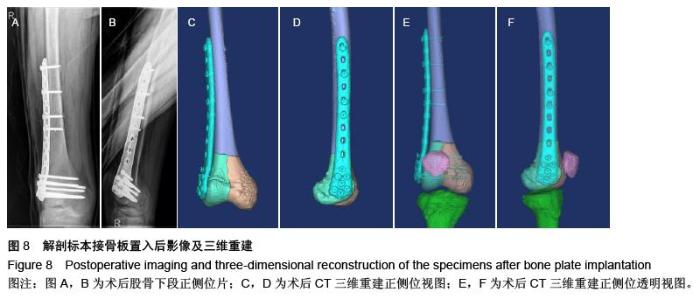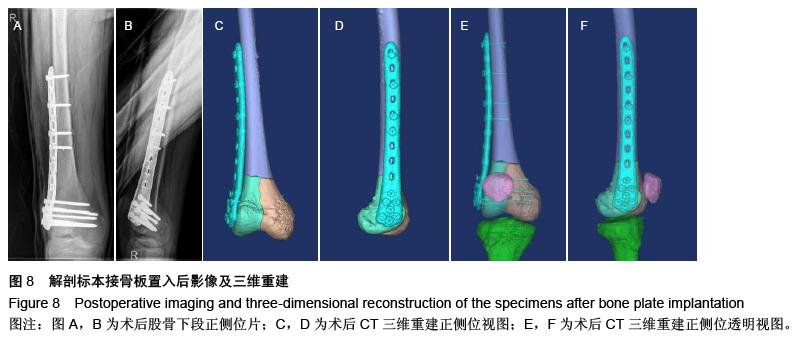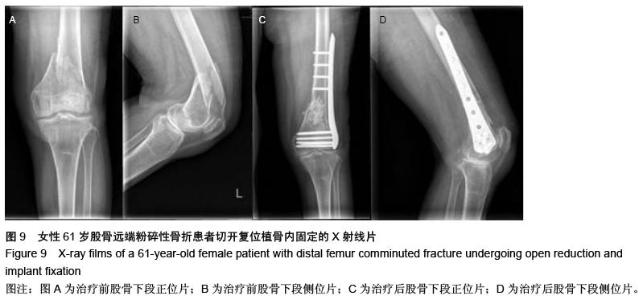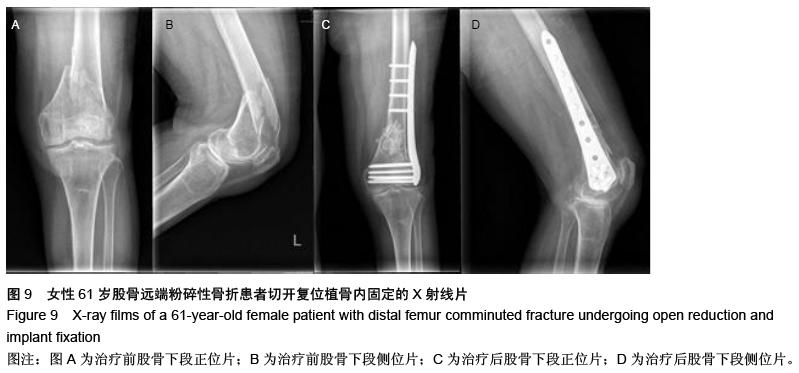| [1] Ellis HB, Ho CA, Podeszwa DA, et al. A comparison of locked versus nonlocked enders rods for length unstable pediatric femoral shaft fractures. J Pediatr Orthop.2011;31(8):825-833.[2] 郑晓晖,张国栋,牛素生,等.术前数字化设计在成人股骨远端C1型骨折钢板内固定中的应用研究[J].中华创伤骨科杂志,2014,16(11):990-995.[3] 陈宣煌,许卫红,黄文华,等. 基于3D打印的腰椎椎弓根螺钉数字化置入及临床应用[J] 中国组织工程研究,2015, 19(17):2752-2757.[4] Rüedi TP, Murphy WM. 骨折治疗的AO 原则[M]. 2 版.王满宜,杨庆铭,曾炳芳,译.上海:上海科学技术出版社, 2010:470-473.[5] Perren SM.The technology of minimally invasive percutaneous osteosynthesis(MIPO). Injury. 2002;33 Suppl 1: VI-VII.[6] Schatzker J,Lambert DC. Supracondylar fractures of the femur. Clin Orthop Relat Res.1979;(138):77-83.[7] Martinet O, Cordey J, Harder Y, et al. The epidemiology of fractures of the distal femur. Injury. 2000;31 (Suppl 3): C62-C63.[8] Moore RE, Baldwin K, Austin MS,et al.A systematic review of open reduction and internal fixation of periprosthetic femur fractures with or without allograft strut, cerclage, and locked plates. J Arthroplasty. 2014;29(5):872-876.[9] Li K,Langdale E,Tashman S,et al. Gender and condylar differences in distal femur morphometry clarified by automated computer analyses.J Orthop Res. 2012;30(5):686-692.[10] Hu Y,Li H,Qiao G,et al.Computer-assisted virtual surgical procedure for acetabular fractures based on real CT data.Injury.2011;42(10):1121-1124.[11] Hu YL,Ye FG,Ji AY,et al. Three-dimensional computed tomography imaging increases the reliability of classification systems for tibial plateau fractures.Injury. 2009;40(12):1282-1285.[12] Messmer P,Brig G,Suhm N,et al.Three-dimensional fracture simulation for preoperative planning and education.Eur J Trauma. 2001;27:171-177.[13] Osti M,Philipp H,Meusburger B,et al.Analysis of failure following anterior screw fixation of Type II odontoid fractures in geriatric patients. Eur Spine J. 2011;20 (11):1915-1920.[14] Shen F,Chen B,Guo Q,et al.Augmented reality patient-specific reconstruction plate design for pelvic and acetabular fracture surgery. Int J Comput Assist Radiol Surg.2013;8(2):169-179.[15] Giannatsis J,Dedoussis V.Additive fabrication technologies applied to medicine and health care: a review. Int J Adv Manuf Technol. 2009;40:116-127.[16] Brown GA,Firoozabakhsh K,DeCoster TA,et al.Rapid prototyping:the future of trauma surgery? J Bone Joint Surg(Am). 2003;85-A Suppl 4: 49-55.[17] Paiva WS,Amorim R,Bezerra DA,et al.Aplication of the stereolithography technique in complex spine surgery. Arq Neuropsiquiatr. 2007;65(2B): 443-445.[18] Doornberg JN,Rademakers MV,van den Bekerom MP,et al.Two-dimensional and three-dimensional computed tomography for the classification and characterisation of tibial plateau fractures. Injury. 2011;42(12):1416-1425.[19] Wu ZX,Huang LY,Sang HX,et al. Accuracy and safety assessment of pedicle screw placement using the rapid prototypingtechnique in severe congenital scoliosis. Spinal Disord Tech.2011;24(7):444-450.[20] Uehara M,Takahashi J,Hirabayashi H,et al. Computer-assisted C1-C2 Transarticular Screw Fixation "Magerl Technique" for Atlantoaxial Instability. Asian Spine J.2012;6(3):168-177.[21] Xie A,Fang C,Huang Y,et al.Application of three-dimensionalreconstruction and visible simulation technique in reoperation of hepatolithiasis. Gastroenterol Hepatol.2013;28(2):248-254. [22] Bagaria V,Deshpande S,Rasalkar DD,et a1.Use of rapid prototyping and three-dimensional reconstruction modeling in the management of complex fractures.Eur J Radiol. 2011;80(3):814-820.[23] Motiei-Langroudi R, Sadeghian H. Assessment of pedicle screw placement accuracy in thoracolumbosacral spine using freehand technique aided by lateral fluoroscopy: results of postoperative computed tomography in 114 patients. Spine J. 2015;15(4):700-704. [24] Sugimoto Y, Ito Y, Tomioka M, et al. Clinical accuracy of three-dimensional fluoroscopy (IsoC-3D)-assisted upper thoracic pedicle screw insertion. Acta Med Okayama.2010;64(3):209-212. [25] Ravi B, Zahrai A, Rampersaud R. Clinical accuracy of computer-assisted two-dimensional fluoroscopy for the percutaneous placement of lumbosacral pedicle screws.Spine. 2011;36(1):84-91. [26] Fuster S, Vega A, Barrios G, et al. Accuracy of pedicle screw insertion in the thoracolumbar spine using image-guided navigation. Neurocirugia.2010; 21(4): 306-311. [27] Eck JC, Lange J, Street J, et al. Accuracy of intraoperative computed tomography-based navigation for placement of percutaneous pedicle screws. Global Spine J. 2013;3(2):103-108. [28] Ammirati M, Salma A. Placement of thoracolumbar pedicle screws using O-arm-based navigation: technical note on controlling the operational accuracy of the navigation system. Neurosurg Rev. 2013;36(1): 157-162. [29] Togawa D, Kayanja MM, Reinhardt MK, et al. Bone-mounted miniature robotic guidance for pedicle screw and translaminar facet screw placement: part 2--Evaluation of system accuracy. Neurosurgery. 2007; 60: 129-139. [30] Bourgeois AC, Faulkner AR, Bradley YC, et al. Improved Accuracy of Minimally Invasive Transpedicular Screw Placement in the Lumbar Spine with Three-dimensional Stereotactic Image Guidance: A Comparative Meta-analysis. J Spinal Disord Tech. 2015;28(9):324-329. [31] Lu S, Zhang YZ, Wang Z, et al. Accuracy and efficacy of thoracic pedicle screws in scoliosis with patient- specific drill template. Med Biol Eng Comput. 2012; 50(7):751-758.[32] Scheufler KM, Cyron D, Dohmen H,et al. Less invasive surgical correction of adult degenerative scoliosis. Part II: Complications and clinical outcome. Neurosurgery. 2010;67: 1609-1621.[33] Lee GY, Massicotte EM, Rampersaud YR. Clinical accuracy of cervicothoracic pedicle screw placement: a comparison of the "open" lamino-foraminotomy and computer-assisted techniques. J Spinal Disord Tech. 2007;20(1):25-32. [34] Ito Y, Sugimoto Y, Tomioka M, et al. Clinical accuracy of 3D fluoroscopy-assisted cervical pedicle screw insertion. J Neurosurg Spine. 2008;9(5):450-453. [35] Rath SA, Moszko S, Schäffner PM, et al. Accuracy of pedicle screw insertion in the cervical spine for internal fixation using frameless stereotactic guidance. J Neurosurg Spine. 2008;8(3):237-245. [36] Hsieh JC, Drazin D, Firempong AO, et al. Accuracy of intraoperative computed tomography image-guided surgery in placing pedicle and pelvic screws for primary versus revision spine surgery. Neurosurgical Focus. 2014;36(3): E2. [37] Tian NF, Huang QS, Zhou P, et al. Pedicle screw insertion accuracy with different assisted methods: a systematic review and meta-analysis of comparative studies. Eur Spine J. 2011;20(6):846-859. [38] Gelalis ID, Paschos NK, Pakos EE, et al. Accuracy of pedicle screw placement: a systematic review of prospective in vivo studies comparing free hand, fluoroscopy guidance and navigation techniques. Eur Spine J. 2012;21(2):247-255.[39] Mason A, Paulsen R, Babuska JM, et al. The accuracy of pedicle screw placement using intraoperative image guidance systems. J Neurosurg Spine. 2014;20(2): 196-203. [40] Smith HE, Welsch MD, Sasso RC, et al. Comparison of radiation exposure in lumbar pedicle screw placement with fluoroscopy vs computer-assisted image guidance with intraoperative three-dimensional imaging. J Spinal Cord Med.2008;31(5): 532-537. [41] Tricot M, Duy KT, Docquier PL. 3 D-corrective osteotomy using surgical guides for posttraumatic distal humeral deformity.Acta Orthop Belg. 2012; 78(4): 538-542. |



